How sheep, variety blends and nutrition can help manage disease
 Some of the Insights farmers are using cheaper, older
chemistry to keep costs down © GNP
Some of the Insights farmers are using cheaper, older
chemistry to keep costs down © GNP Fungicides remain a central pillar in controlling disease on our Arable Insights farmer panel’s farms, despite most wishing to reduce chemical inputs as much as possible.
However, managing nitrogen and nutrients carefully, using the power of the hoof, as well as careful variety selections (including blends) are the tools being used to minimise risk before resorting to the can.
See also: Septoria-specific spray is key for Dorset wheat grower
Wales: Richard Anthony

© Supplied by Richard Anthony
All forward wheats grown by Richard Anthony across the 1,200ha business are grazed by sheep to help reduce disease pressure as well as provide growth regulation.
Whole fields are mob grazed by flocks partly owned by the farm and partly from a neighbour.
Managing the process is key, says Richard, and involves a flock of up to 4,000 sheep moving from grazing Westerwold ryegrass in the autumn onto the forward wheats during January and February.
“You must be willing to move the sheep, especially if the weather is wet. If necessary, we will move to the next field and then back.”
Fields are grazed down to about 40-60mm height, with trampling of side leaves also helpful in removing disease from the crop.
“We’re getting better at managing grazing, having come back to it in the past few years. I’ve more confidence in what we’re doing, and our wheats are as clean this year as they’ve ever been,” he says.
A shortage of forward wheats this season because of delayed drilling, however, is bringing about plans to drill fields earlier next autumn.
Grazing saves needing to use a fungicide before T1, and if disease pressure remains low, he can also reduce spend at T1.
Positive experience with Miravis Plus last season in a high-pressure situation on one field means that could be a T2 option, but weather will determine the spend, he says.
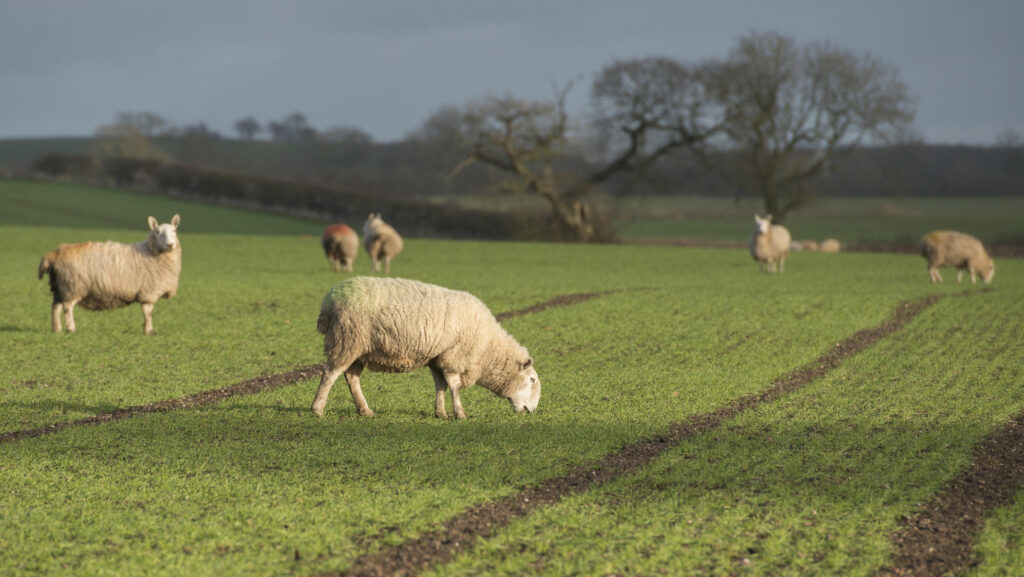
Two of the Insights farmers are grazing wheat with sheep to manage disease © Alamy Stock Photo
Active ingredients
- Ascra Xpro – bixafen + fluopyram + prothioconazole
- Comet – pyraclostrobin
- Era – prothioconazole
- Miravis Plus – pydiflumetofen
- Revystar – fluxapyroxad + mefentrifluconazole
- Univoq – fenpicoxamid + prothioconazole
- Vimoy – isoflucypram
South West: John Farrington
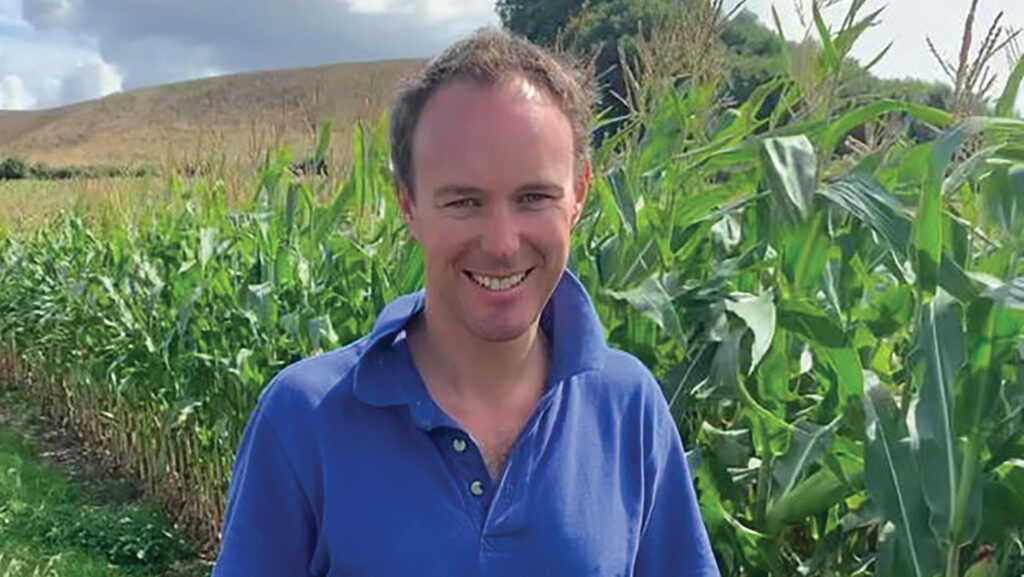
© Supplied by John Farrington
John Farrington is the second member of the panel to use sheep to control early-season disease on winter cereals.
He uses a slightly different approach to Richard in dividing whole fields into smaller blocks before mob grazing with lighter ewe lambs, which helps prevent the sheep from running tramlines and limiting damage.
“It does take extra management time, but it gives us some extra grazing, which is helpful in our all-year-round outdoor system.”
Experience has shown the crops can be grazed quite hard with regrowth happening within a week. Ideally, grazing is completed in February before first applications of nitrogen applied.
The grazing eliminates any need for a T0, with a two or three spray fungicide programme to follow depending on disease pressure, with septoria the main concern. Univoq has been used as a T2 spray in recent years with good results.
With the farm transitioning to regenerative principles, John is keen to reduce inputs and grows feed wheat variety blends with varieties with good disease resistance to septoria.
But he’s already found its easily possible to cut too much, too soon.
“It needs to be a whole farm approach to weaning off fungicides completely, and we’re not far enough through the transition yet,” he says.

Septoria in winter wheat © Blackthorn Arable
East Anglia: Jo Franklin
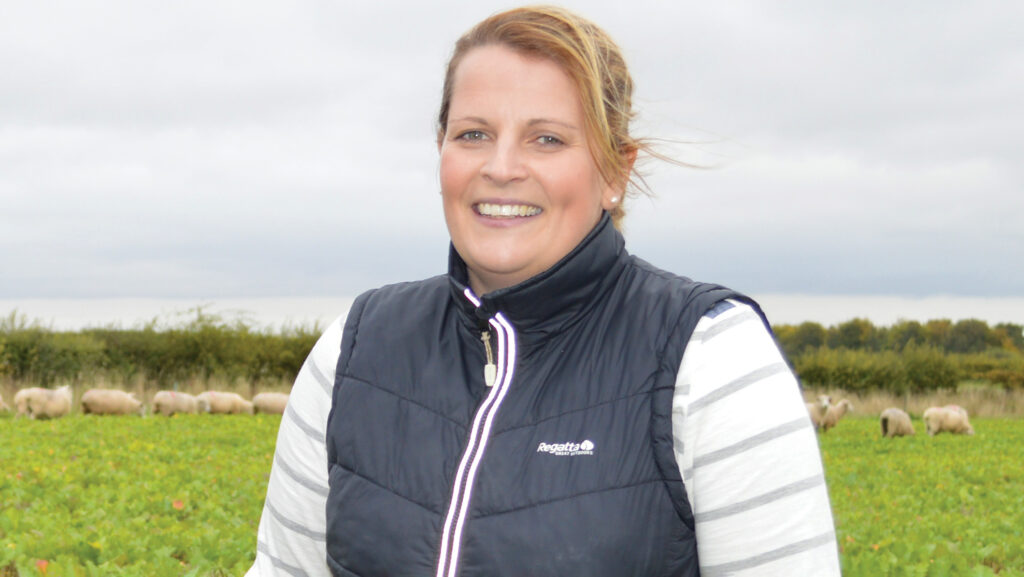
Jo Franklin © MAG/David Jones
It’s perhaps a little bit of a surprise, given the mixed sheep and arable farm run by Jo Franklin and partner Rob Hodgkins, that grazing cereals with sheep isn’t routinely part of their disease control programme.
But while some forward wheat is grazed on occasion, especially if Jo can foresee an early season rust risk that would otherwise require a T0 fungicide, the lack of infrastructure and labour requirements have mostly made it a non-starter on the farm.
“We have 2,500 ewes and 3,500-4,000 lambs, so it requires an enormous amount of fencing equipment – it’s not a money-saving job.
“You also have a feed budget for the sheep, and if wheat is a big part of the plan, it’s got to be there, which is a lot of pressure. It’s trickier than it looks,” she says.
Instead, Jo concentrates on nutrition as a first line of defence, alongside varietal disease resistance.
“We work hard not to over fertilise at any point – if you get that right, you don’t need as much fungicide.”
The generally drier climate in the East also reduces disease pressure, especially from septoria, meaning that Jo typically starts programmes with an azole base of prothioconazole, mixed with a partner product that works out to be the most cost-effective.
“We typically end up using some cheaper first-generation SDHI, although there is no technical need for them where we are, other than to prolong the life of prothioconazole.
“Our programme will probably cost between £75-£90/ha, unless yellow rust comes in when you have to grab some Comet.”
East Midlands – Colin Chappell

Colin Chappell © Alan Bennett
Later drilling is an easy win for Colin Chappell, who farms nears Brigg. While this is primarily driven for its impact on blackgrass, it has the added benefit of reducing risk from septoria.
Colin tries to minimise risk from rusts using uses varietal resistance. However, growing milling wheat for Warburtons means Crusoe, with its brown rust risk, is difficult to avoid, and growing for seed also restricts choice.
A major part of his disease management is to avoid applying luxurious amounts of freely available nitrate fertiliser, which thins cell walls and lets in disease, he says.
He uses molasses to help control and slow down uptake of his urea ammonium nitrate (UAN) applications to minimise available nitrate.
“Get nitrogen management right, and the rest starts to fall into place,” he says.
He is finding applying silicon and potassium – as well as manganese – early in the season helps build healthier plants.
Silicon acts as a barrier to prevent initial infections, and avoiding using T0 fungicides delays the removal of leaf wax, which also acts as an infection barrier, he suggests.
“I’m also concerned about fungicides touching soil – we know soils contain fungi and I don’t know what a fungicide will do to the soil microbiome, but logically it isn’t going to be good.
“If I need to apply fungicides later in the season, the chances of hitting the soil are less.”
On his non-seed crops, he is trying to avoid using fungicides for as long as possible – managing to get to T3s on Skyfall without an application in a previous season.
This year, Bamford is the targeted variety to avoid applications until at least T2. “As soon as you apply a fungicide, you’re into the three- to four-week cycle.”
But where he does need to apply a fungicide, he won’t skimp Miravis Plus + Era is under consideration, although the approximate £15/ha premium over Univoq is making that more attractive.
“If I have saved up to that point, then why not use the best products,” he says.
South East: Barney Tremaine
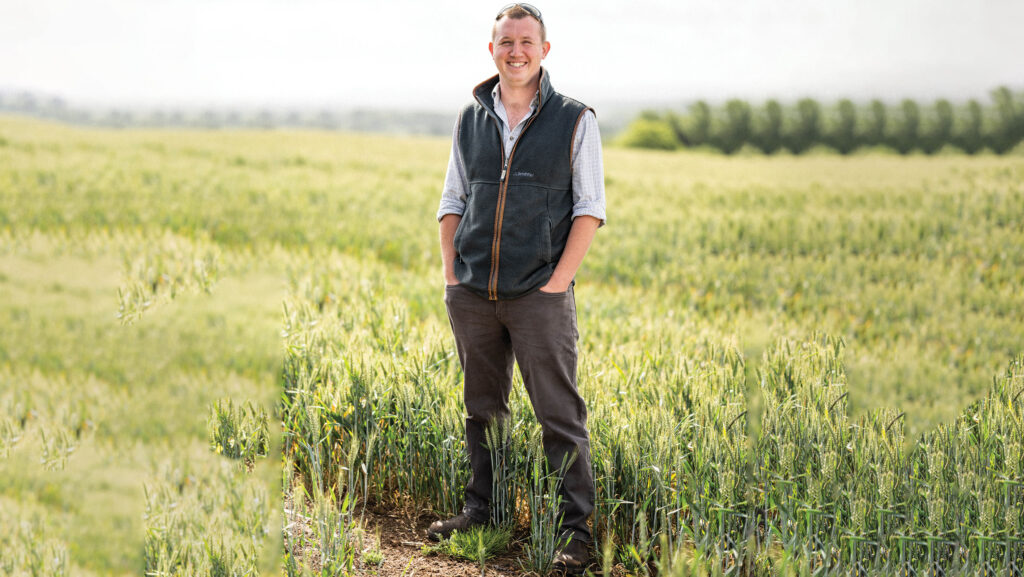
Barney Tremaine © Matt Austin
Growing wheat for Wildfarmed is proving a useful testing ground for alternative disease control measures at Cowdray Home Farm in Sussex, says farm manager Barney Tremaine.
Wildfarmed protocols specify the growing of variety blends, the use of sap analysis to tailor nutrition programmes with limits on total nitrogen applications, and zero fungicides.
“It provides an interesting comparison. We had Wildfarmed crops doing over 5t/ha in places, on some of the better fields, while on the same soil type, we had yields of 6.5t/ha with a full nitrogen and fungicide programme.
“That suggested we were not doing something right and the latter was a very inefficient crop.”
Within the reduced area 200ha of wheat being grown this season, he has wheat variety blends, alongside varieties such as Nelson, Dawsum and Mayflower.
Brown rust and septoria are the main concerns, with visual observations suggesting that growing a blend has reduced disease pressure.
“We grew a milling wheat blend of Extase, Illustrious, Crusoe and Nelson as a 5ha trial and didn’t see active brown rust compared with a field of Crusoe close by where we were.”
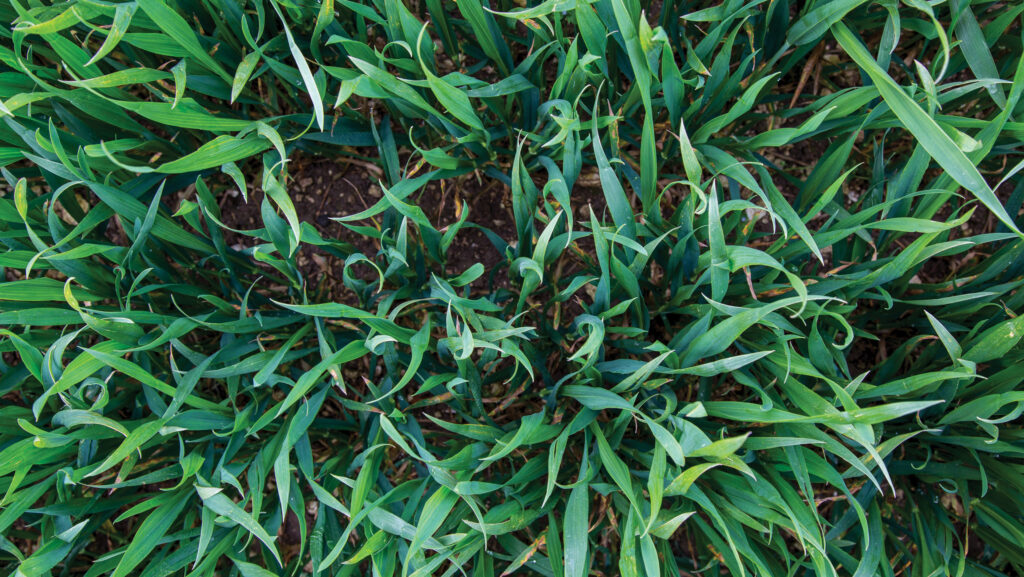
Wheat variety blends help reduce disease pressure © GNP
That could allow the use of reduced fungicides on blends, although evidence is more anecdotal than supported with yield data currently, he says.
He’s also experimenting with sap analysis to help balance nutrition on his conventional wheat as well as with Wildfarmed crops, with applications informed by NovaCropControl’s benchmarks, particularly where there are large differences between field analysis and benchmarked figures.
“I also think not dialling up high N doses, using more split doses and some foliars, is lowering pressure.”
But fungicides remain an important part of the strategy, with two sprays the aim, although depending on season it can become a three-spray programme.
“We did a strong T1 last year and don’t regret that.”
Options for this year include Vimoy at that timing, with Univoq at T2.
“I don’t particularly like Univoq as a product – we’ve had a lot of problems with sprayer diaphragms, but it does give good result from a value for activity perspective.”
South Midlands: Charles Paynter

© Supplied by Charles Paynter
Despite a transition to regenerative practices, disease control at Rifle Range Farm in Bedfordshire is still conventional, partly due to using contractors for spraying, says Charles Paynter.
But that might be about to change with the purchase of a second-hand sprayer to enable applications of biological and nutritional products and employing well-known biological farmer Tim Parton to provide some specialist advice.
“The idea is to improve plant nutrition to build up the plant’s resistance to disease.”
A biological approach to disease control is likely to be more intensive in terms of management and number of passes, so taking those applications back in-house make the expense more palatable than using a contractor charging around £15/ha an application, he says.
“It’s got to be something worthwhile to spend that kind of money on a regular basis.”
It’s likely the new approach will be implemented on a trial basis to begin with, given the need to minimise risk and maintaining profitability, he says.
Where fungicides are used this season, the current plan is to apply either Ascra or Revystar at T1, with Univoq the T2 choice.
North: Philip Metcalfe

Philip Metcalfe © Jim Varney
A trial last season to multiply up a blend of Palladium, Extase, Gleam and Dawsum, which the AHDB blend tool suggested was a good mix, showed a 3.6% yield increase over the average of the two farm standard varieties Gleam and Dawsum for Philip Metcalfe in Yorkshire.
That’s encouraged him to grow 16ha of the blend in two fields this season, with the intention of trialling a reduction in fungicide to exploit the diversity and improved disease resistance from the blend.
He’s also considering using a tea extract made from compost made using the Johnson-Su method on a tramline with the hope that it will boost the plant’s natural defences against diseases.
With septoria and yellow rust the main threats, Philip usually employs a three-spray fungicide programme, with the ear spray an important component to produce a bright grain sample for his seed crops.
Typically, he is using older SDHI chemistry rather than the latest actives, with further savings coming from spending time finding the best prices.
“I get quotes from three different companies for each spray timing. It takes a bit of time and analysis of the products to work out the best deal, but I’m saving around 15% by using the cheapest versus the average of the three quotes.”
Scotland: Doug Christie
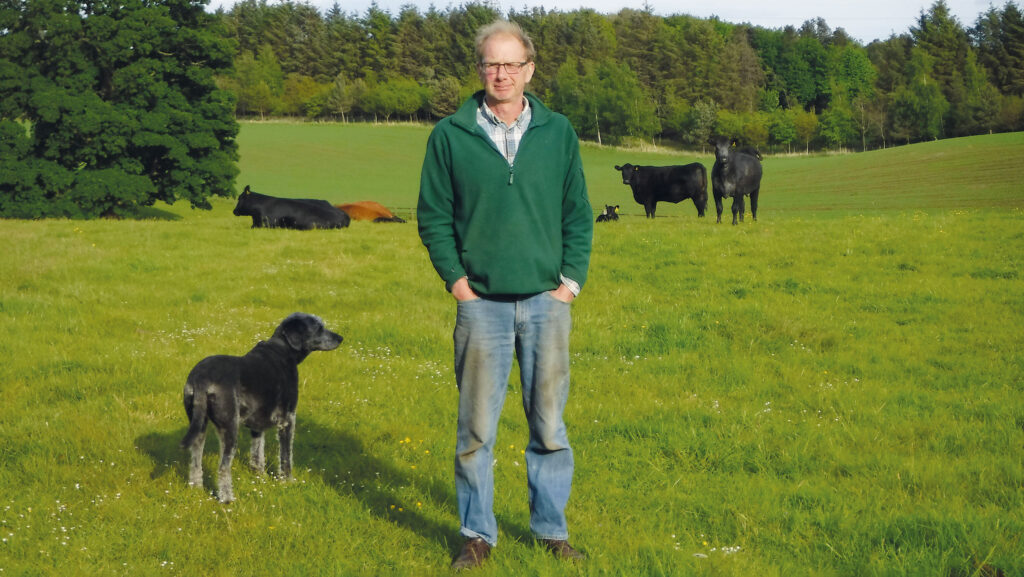
© Supplied by Doug Christie
Within the group, no one spends less on fungicides than Doug Christie in Scotland, with an average cost of £60/ha on wheat over the past five years, partly as the result of using older chemistry.
Rates are decided depending on disease pressure, but the three main timings are typically used.
“I only just started using SDHI chemistry in 2022,” he says.
He uses varietal disease resistance, especially to septoria, as much as possible with yellow rust the other main threat more easily controlled with cheap chemistry, such as tebuconazole and prothioconazole, and in the past before it lost approval, epoxiconazole. Mancozeb has also proved useful cheap disease control.
“I know these chemicals are not as effective against septoria now, but I haven’t seen bad infestations when I’ve been using them.”
James Hutton Institute research at the farm in 2019 also suggested that his long-term “mature” no-till system might be dampening down disease infections, particularly yellow rust in wheat and powdery mildew in barley.
An explanation for the research finding could be that continuous zero tillage keeps mycorrhizal networks intact – these could help prime plant resistance against disease.
“There’s obviously something happening in the soil that’s helping plants fight disease,” he says.

